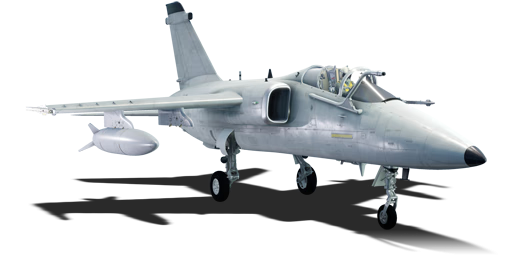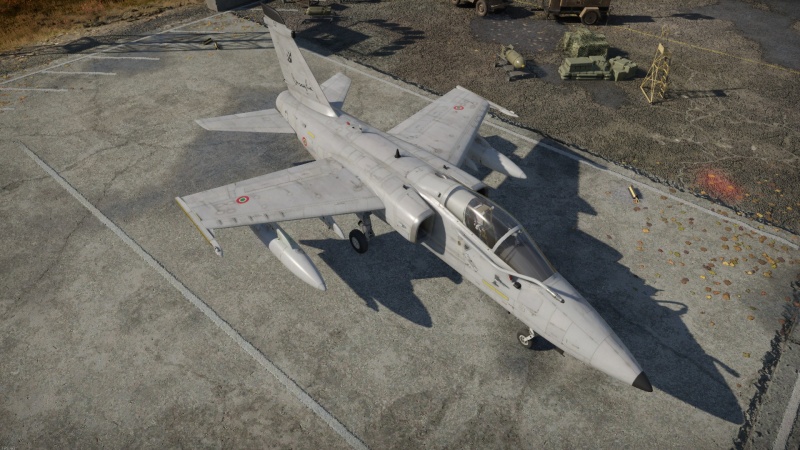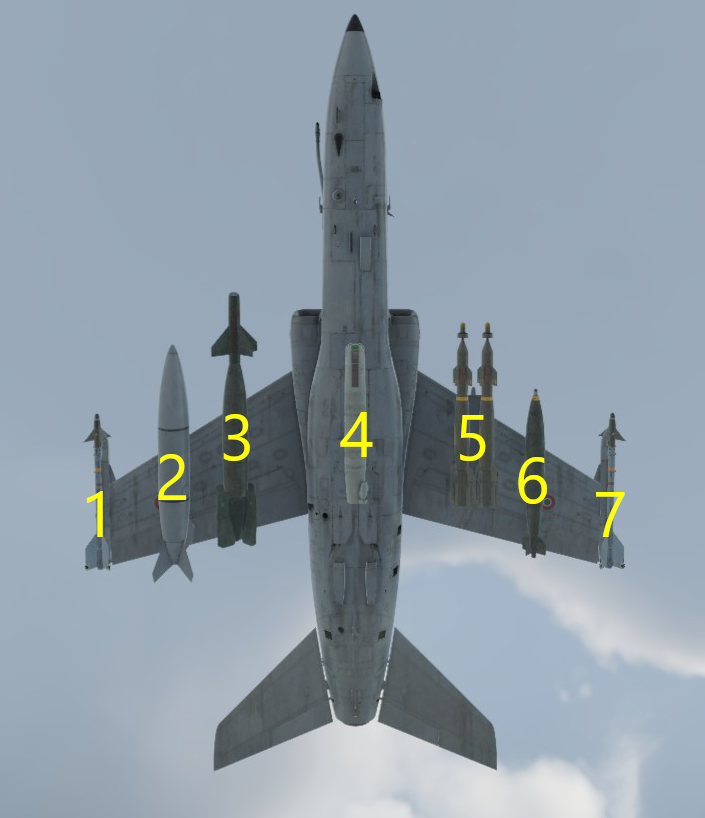Difference between revisions of "AMX"
(Tag: Visual edit) |
(Pro/con additions) |
||
| Line 212: | Line 212: | ||
* Great payload options | * Great payload options | ||
| + | ** GBUs and thermals provide strong and accurate ground strike options for Ground Battles | ||
* Internal mounted countermeasures | * Internal mounted countermeasures | ||
* Relatively nimble for a strike aircraft | * Relatively nimble for a strike aircraft | ||
* AIM-9Ls are potent in a downtier | * AIM-9Ls are potent in a downtier | ||
| + | ** Gun radar can be used to detect enemies or slave your AIM-9Ls | ||
'''Cons:''' | '''Cons:''' | ||
* Rather limited ammo for Vulcan standards | * Rather limited ammo for Vulcan standards | ||
| − | * | + | * Slow acceleration at lower speeds, struggles with larger payloads |
| − | * | + | * Subsonic speed |
| + | ** Bleeds most of its energy in dogfights quickly, poor acceleration means you will almost always be on the defensive | ||
| + | * Once your AIM-9Ls are expended you are mostly helpless | ||
== History == | == History == | ||
Revision as of 06:16, 21 May 2024
Contents
Description
The AMX International AMX, known in Italian service as A-11 Ghibli, is a joint venture between Alenia and Aermacchi of Italy, and EMBRAER of Brazil. Italy initiated a requirement for a new aircraft to replace the Fiat G.91 Y's that were in service, while Brazil joined the venture primarily to replace an Italian aircraft in their service, the Aermacchi MB-326. After several prototypes, the AMX was adopted into service by the air forces of both Italy and Brazil. Initially, the primary variant in service was the A-11A, with the AMX-T serving as the dual-seater trainer variant. The AMX served for many decades and demonstrated its worth in multiple deployments. The variant featured in the game is the A-11B / AMX ACOL. The AMX ACOL was a further upgrade which outfitted 55 AMX-11A aircraft with new avionics. These enhancements included the addition of an INS/GPS navigation system, new communication systems, IFF, and new HUD displays. The most significant addition to the upgrade was the capability to deploy smart munitions, such as JDAM bombs, which later played an essential role in its deployment in Afghanistan.
It was introduced in Update "Air Superiority". As a subsonic strike aircraft, it will fly similarly to other planes in its role, such as the A-10, Su-25, Harrier, and, most notably, the A-6E TRAM. While it is capable of carrying up to two AIM-9Ls and comes equipped with internal countermeasures, it can also be used, though not intended, in an air-to-air role. This is preferably done when the pylons aren't loaded with ordnance, as it significantly affects the plane's performance. When utilized for its intended role, the AMX can carry up to six GBU Paveway II guided bombs or eight "dumb" unguided bombs. These capabilities can be devastating for enemy ground forces while showcasing the AMX's value as a formidable Close Air Support plane for allied forces.
General info
Flight performance
Describe how the aircraft behaves in the air. Speed, manoeuvrability, acceleration and allowable loads - these are the most important characteristics of the vehicle.
| Characteristics | Max speed (km/h at _,___ m) |
Max altitude (metres) |
Turn time (seconds) |
Rate of climb (metres/second) |
Take-off run (metres) | |||
|---|---|---|---|---|---|---|---|---|
| AB | RB | AB | RB | AB | RB | |||
| Stock | ___ | ___ | 12500 | __._ | __._ | __._ | __._ | ___ |
| Upgraded | ___ | ___ | __._ | __._ | __._ | __._ | ||
Details
| Features | |||||
|---|---|---|---|---|---|
| Combat flaps | Take-off flaps | Landing flaps | Air brakes | Arrestor gear | Drogue chute |
| ✓ | ✓ | ✓ | ✓ | X | X |
| Limits | ||||||
|---|---|---|---|---|---|---|
| Wings (km/h) | Gear (km/h) | Flaps (km/h) | Max Static G | |||
| Combat | Take-off | Landing | + | - | ||
| 1,180 | 444 | 850 | 793 | 500 | ~__ | ~__ |
| Optimal velocities (km/h) | |||
|---|---|---|---|
| Ailerons | Rudder | Elevators | Radiator |
| < 650 | < 650 | < 650 | - |
Engine performance
| Engine | Aircraft mass | ||||||
|---|---|---|---|---|---|---|---|
| Engine name | Number | Basic mass | Wing loading (full fuel) | ||||
| Rolls-Royce Spey 807 | 1 | 6,807 kg | 417 kg/m2 | ||||
| Engine characteristics | Mass with fuel (no weapons load) | Max Gross Weight | |||||
| Weight (each) | Type | 10m fuel | 20m fuel | 30m fuel | 34m fuel | ||
| 1,856 kg | Low-bypass turbofan | 7,644 kg | 8,447 kg | 9,269 kg | 9,597 kg | 13,550 kg | |
| Maximum engine thrust @ 0 m (RB/SB) | Thrust to weight ratio @ 0 m (100%) | ||||||
| Condition | 100% | WEP | 10m fuel | 20m fuel | 30m fuel | 34m fuel | MGW |
| Stationary | 4,719 kgf | - | 0.62 | 0.56 | 0.51 | 0.49 | 0.35 |
| Optimal | 5,120 kgf (1,000 - 1,180 km/h) |
- | 0.67 | 0.61 | 0.55 | 0.53 | 0.38 |
Survivability and armour
Examine the survivability of the aircraft. Note how vulnerable the structure is and how secure the pilot is, whether the fuel tanks are armoured, etc. Describe the armour, if there is any, and also mention the vulnerability of other critical aircraft systems.
Modifications and economy
Armaments
| Ballistic Computer | ||||
|---|---|---|---|---|
| CCIP (Guns) | CCIP (Rockets) | CCIP (Bombs) | CCRP (Bombs) | Lead indicator |
| |
|
|
|
|
Offensive armament
The AMX is armed with:
- 1 x 20 mm M61A1 cannon, chin-mounted (400 rpg)
- 120 x countermeasures
Suspended armament
The AMX can be outfitted with the following ordnance:
| 1 | 2 | 3 | 4 | 5 | 6 | 7 | ||
|---|---|---|---|---|---|---|---|---|
| 277 kg GBU-12 Paveway II bombs | 1* | 1, 2 * | 1, 2 * | 1* | ||||
| 500 lb LDGP Mk 82 bombs | 1 | 1, 2 | 1, 2 | 1, 2 | 1 | |||
| 500 lb Mk 82 Snakeye bombs | 1 | 1, 2 | 1, 2 | 1, 2 | 1 | |||
| 1,000 lb LDGP Mk 83 bombs | 1 | 1 | 1, 2 | 1 | 1 | |||
| 1,092 lb GBU-16 Paveway II bombs | 1* | 1* | 1* | 1* | ||||
| 2,000 lb LDGP Mk 84 bombs | 1 | 1 | 1 | |||||
| 2,000 lb GBU-24 Paveway III bombs | 1* | 1* | ||||||
| BLU-1 incendiary bombs | 1 | 1 | 1 | 1 | 1 | |||
| ARF/8M3(AP-AT) rockets | 25 | 25, 50 | 25, 50 | 25 | ||||
| AIM-9L Sidewinder missiles | 1 | 1 | ||||||
| CLDP targeting pod | 1* | |||||||
| 580 l drop tanks | 1 | 1 | ||||||
| Maximum permissible weight imbalance: 1,500 kg | ||||||||
| * CLDP pod must be equipped when equipping guided bombs | ||||||||
| Default weapon presets | |
|---|---|
| |
Usage in battles
Describe the tactics of playing in the aircraft, the features of using aircraft in a team and advice on tactics. Refrain from creating a "guide" - do not impose a single point of view, but instead, give the reader food for thought. Examine the most dangerous enemies and give recommendations on fighting them. If necessary, note the specifics of the game in different modes (AB, RB, SB).
Pros and cons
Pros:
- Great payload options
- GBUs and thermals provide strong and accurate ground strike options for Ground Battles
- Internal mounted countermeasures
- Relatively nimble for a strike aircraft
- AIM-9Ls are potent in a downtier
- Gun radar can be used to detect enemies or slave your AIM-9Ls
Cons:
- Rather limited ammo for Vulcan standards
- Slow acceleration at lower speeds, struggles with larger payloads
- Subsonic speed
- Bleeds most of its energy in dogfights quickly, poor acceleration means you will almost always be on the defensive
- Once your AIM-9Ls are expended you are mostly helpless
History
The story of AMX International began with a joint cooperation between Alenia-Aermacchi of Italy and EMBRAER of Brazil. The project emerged from the need to find a suitable replacement for the G.91 Y and to assume its role as a ground attacker. The G.91 Y was becoming outdated and unreliable, prompting the search for a more modern aircraft. Italy also sought an advanced multi-role platform with reconnaissance capabilities. Brazil joined the collaboration to replace the outdated Aermacchi MB-326, which was not adapted for modern warfare.
After several years of development, setbacks in the form of accidents, and prototype testing, the A-11 officially entered service in Italy by 1989. One of its main advantages as a fighter and attack aircraft is its significantly lower costs compared to its competitors. The A-11s are equipped with a variant of the EL/M-20001B radar, manufactured by Fiar in Italy and designed by Elta in Israel.
The A-11A has an extensive service record, thanks to its versatile armament options, including AIM-9L infrared-guided Sidewinder air-to-air missiles, as well as various bombs, rockets, and PGMs. The Italian version features a 20 mm M61A1 Vulcan cannon, while the Brazilian version uses 30 mm Defa cannons due to a U.S. veto on the M61A1 cannon for Brazil.
For defence, the AMX is equipped with an active and passive electronic countermeasures system supplied by Elettronica, with the RWR mounted inside the tail fin. In terms of performance, the A-11 can reach speeds of 1053 km/h, thanks to the Rolls-Royce Spey 807 turbofan engine, providing a range of 889 km. Its rate of climb and service ceiling are impressive for an aircraft of its type.
Later in its service life, the A-11 received an upgrade known as the A-11B / AMX ACOL (Aggiornamento Capacità Operative e Logistiche; Update to Logistical and Operative Capabilities), a mid-life update aimed at enhancing logistical and operative capabilities. This update included new avionics, an INS/GPS navigation system, improved communications systems, IFF, and new HUD displays. The most significant addition was the ability to deploy smart munitions, such as JDAM bombs, allowing A-11s to provide better close air support in Afghanistan. The A-11B first flew in September 2005, with the first batch of upgraded aircraft delivered in March 2007. The A-11B remains in service and is likely to continue so for the foreseeable future.
Media
- Skins
- Videos
See also
- Aircraft of comparable role, configuration and era
External links
| AMX International Ltd. | |
|---|---|
| Jet Aircraft | AMX · AMX A-1A |
| Note | AMX International is an joint-venture to develop, manufacture and market the AMX aircraft and is unrelated to the Tank Manufacturer AMX |
| Italy jet aircraft | |
|---|---|
| Aerfer | Sagittario 2 · Ariete |
| Fiat | G.91 pre-serie · G.91 R/1 · G.91 R/4 (Portugal) · G.91 Y · G.91 YS |
| AMX International | AMX · AMX A-1A (Brazil) |
| Panavia | Tornado ADV · ▄Tornado IDS · ▄Tornado IDS (1995) |
| Foreign: | |
| Vampire | Vampire FB 52A |
| F-84 | ▄F-84F · ▄F-84G-21-RE |
| F-86 | CL-13 Mk.4 · ▄F-86K |
| F-104 | ▄F-104G · F-104S · ▄F-104S TAF (Turkey) · F-104S.ASA |
| F-16 | ▄F-16A ADF |
| AV-8 | ▄AV-8B Plus |
| Hungary | |
| Mikoyan-Gurevich | ◔MiG-15bis · ◔MiG-17PF · ◔MiG-21MF · ◔MiG-21bis-SAU · ◔MiG-23MF · ◔MiG-29 |
| Ilyushin | ◔IL-28 |
| Sukhoi | ◔Su-22M3 |
| Saab | ◔JAS39EBS HU C |






